Gas Emissions and Environmental Benefits of Wheat Cultivated under Different Fertilization Managements in Mollisols
Abstract
:1. Introduction
2. Materials and Methods
2.1. Experimental Site and Soil Description
2.2. Experimental Design and Treatments
2.3. Calculation of Cumulative Soil NH3, N2O and CO2 Emissions
2.4. Soil Sampling and Analysis
2.5. Data Analysis
3. Results
3.1. Soil NH3 Volatilization
3.2. Soil N2O Emissions
3.3. Soil CO2 Emissions
3.4. Soil NH3, N2O and CO2 Environmental Benefits
3.5. Soil pH, SOM, Total N, NH4+-N and NO3−-N Contents
3.6. Soil Enzyme Activity
4. Discussion
4.1. Soil NH3 Volatilization
4.2. Soil N2O Emissions
4.3. Soil CO2 Emissions
4.4. Limitations
5. Conclusions
6. Prospect
Author Contributions
Funding
Institutional Review Board Statement
Informed Consent Statement
Data Availability Statement
Acknowledgments
Conflicts of Interest
References
- Herrera, J.; Rubio, G.; Häner, L.; Delgado, J.; Lucho-Constantino, C.; Islas-Valdez, S.; Pellet, D. Emerging and established technologies to increase nitrogen use efficiency of cereals. Agronomy 2016, 6, 25. [Google Scholar] [CrossRef] [Green Version]
- Wen, X.; Hu, C.X.; Sun, X.C.; Zhao, X.H.; Tan, Q.L. Research on the nitrogen transformation in rhizosphere of winter wheat (Triticum aestivum) under molybdenum addition. Springer 2019, 26, 2363–2374. [Google Scholar] [CrossRef] [PubMed]
- Lasisi, A.A.; Akinremi, O.O.; Kumaragamage, D. Efficiency of fall versus spring applied urea-based fertilizers treated with urease and nitrification inhibitors II. Crop yield and nitrogen use efficiency. Soil Sci. Soc. Am. J. 2021, 85, 299–313. [Google Scholar] [CrossRef]
- Huang, S.; Lv, W.S.; Bloszies, S.; Shi, Q.H.; Pan, X.H.; Zeng, Y.J. Effects of fertilizer management practices on yield scaled ammonia emissions from croplands in China: A meta-analysis. Field Crop. Res. 2016, 192, 118–125. [Google Scholar] [CrossRef]
- Payandeh, Z.; Jahanbakhshi, A.; Mesri-Gundoshmian, T.; Clark, S. Improving Energy Efficiency of Barley Production Using Joint Data Envelopment Analysis (DEA) and Life Cycle Assessment (LCA): Evaluation of Greenhouse Gas Emissions and Optimization Approach. Sustainability 2021, 13, 6082. [Google Scholar] [CrossRef]
- Zhan, X.Y.; Adalibieke, W.; Cui, X.Q.; Winiwarter, W.; Reis, S.; Zhang, L.; Bai, Z.H.; Wang, Q.H.; Huang, W.C.; Zhou, F. Improved Estimates of Ammonia Emissions from Global Croplands. Environ. Sci. Technol. 2021, 55, 1329–1338. [Google Scholar] [CrossRef] [PubMed]
- Zamanian, K.; Kuzyakov, Y. Contribution of soil inorganic carbon to atmospheric CO2: More important than previously thought. Glob. Change Biol. 2019, 25, e1–e3. [Google Scholar] [CrossRef] [PubMed] [Green Version]
- Wang, Y.; Zhou, M.; Hou, M.; Chen, Y.M.; Sui, Y.Y.; Jiao, X.G. Regulation of nitrogen balance and yield on greenhouse eggplant under biochar addition in Mollisol. Plant Soil Environ. 2022, 68, 36–48. [Google Scholar] [CrossRef]
- Lan, T.; Li, M.X.; Han, Y.; Deng, O.P.; Tang, X.Y.; Luo, L.; Zeng, J.; Chen, G.D.; Yuan, S.; Wang, C.Q.; et al. How are annual CH4, N2O, and NO emissions from rice–wheat system affected by nitrogen fertilizer rate and type? Appl. Soil Ecol. 2020, 150, 103469. [Google Scholar] [CrossRef]
- Hayes, F.; Lloyd, B.; Mills, G.; Jones, L.; Dore, A.J.; Carnell, E.; Viene, M.; Dise, N.; Fenner, N. Impact of long-term nitrogen deposition on the response of dune grassland ecosystems to elevated summer ozone. Environ. Pollution. 2019, 253, 821–830. [Google Scholar] [CrossRef] [PubMed]
- Min, J.; Sun, H.J.; Kronzucker, H.J.; Wang, Y.; Shi, W.M. Comprehensive assessment of the effects of nitrification inhibitor application on reactive nitrogen loss in intensive vegetable production systems. Agric. Ecosyst. Environ. 2021, 307, 107227. [Google Scholar] [CrossRef]
- Bradford, M.A.; Wieder, W.; William, R. Managing uncertainty in soil carbon feedbacks to climate change. Nat. Clim. Change 2016, 6, 751–758. [Google Scholar] [CrossRef] [Green Version]
- Liu, S.W.; Cheng, J.; Wang, C.; Chen, J.; Jin, Y.G.; Zou, Z.H.; Li, S.Q.; Niu, S.L.; Zou, J.W. Climatic role of terrestrial ecosystem under elevated CO2: A bottom-up greenhouse gases bud-get. Ecol. Lett. 2018, 21, 1108–1118. [Google Scholar] [CrossRef] [PubMed] [Green Version]
- Okami, M.; Matsunaka, H.; Fujita, M. Analysis of yield-attributing traits for high-yielding wheat lines in southwestern Japan. Plant Prod. Sci. 2016, 19, 360–369. [Google Scholar] [CrossRef] [Green Version]
- Zhou, M.; Wang, C.Y.; Xie, Z.H.; Li, Y.S.; Zhang, X.Y.; Wang, G.H.; Jin, J.; Ding, G.W.; Liu, X.B. Humic substances and distribution in Mollisols affected by six-year organic amendments. Agron. J. 2020, 112, 4723–4740. [Google Scholar] [CrossRef]
- Zhou, B.Y.; Sun, X.F.; Ding, Z.S.; Ma, W.; Zhao, M. Multisplit nitrogen application via drip irrigation improves maize grain yield and nitrogen use efficiency. Crop Sci. 2017, 57, 1687–1703. [Google Scholar] [CrossRef] [Green Version]
- Ni, B.; Liu, M.; Lu, S.; Xie, L.; Wang, Y. Multifunctional slow-release organic–inorganic compound fertilizer. J. Agric. Food Chem. 2010, 58, 12373–12378. [Google Scholar] [CrossRef]
- Zhao, J.; Ni, T.; Li, J.; Lu, Q.; Fang, Z.Y.; Huang, Q.W.; Zhang, R.F.; Li, R.; Shen, B.; Shen, Q. Effects of organic–inorganic compound fertilizer with reduced chemical fertilizer application on crop yields, soil biological activity and bacterial community structure in a rice-wheat cropping system. Appl. Soil Ecol. 2016, 99, 1–12. [Google Scholar] [CrossRef]
- Ti, C.; Xia, L.; Chang, S.X.; Yan, X.Y. Potential for mitigating global agricultural ammonia emission: A meta-analysis. Environ. Pollut. 2019, 245, 141–148. [Google Scholar] [CrossRef]
- Zhang, D.J.; Zong, J.J.; Ma, J.H.; Yang, X.Q.; Hu, X.; Xu, S. Effects of annual whet-maize tillage and organic fertilizer application on soil organic carbon pool and greenhouse gas emission of summer maize. Ecol. Environ. Sci. 2019, 28, 1927–1935, (In Chinese with English abstract). [Google Scholar]
- Zhou, W.; Tian, Y.H.; Yin, B. Ammonia volatilization and nitrogen balance after topdressing fertilization in paddy fields of Taihu Lake region. Chin. J. Eco-Agric. 2011, 19, 32–36, (In Chinese with English abstract). [Google Scholar] [CrossRef]
- Sinsabaugh, R.L.; Shah, J.J.F. Ecoenzymatic stoichiometry and ecological theory. Annu. Rev. Ecol. Evol. Syst. 2012, 43, 313–343. [Google Scholar] [CrossRef] [Green Version]
- Chen, J.; Elsgaard, L.; Groenigen, K.J.; Olesen, J.E.; Liang, Z.; Jiang, Y.; Lærke, P.E.; Zhang, Y.F.; Luo, Y.Q.; Hungate, B.A.; et al. Soil carbon loss with warming: New evidence from carbon-degrading enzymes. Glob. Change Biol. 2020, 26, 1944–1952. [Google Scholar] [CrossRef]
- Gu, B.J.; Ge, Y.; Ren, Y.; Xu, B.; Luo, W.D.; Jiang, H.; Gu, B.H.; Chang, J. Atmospheric Reactive Nitrogen in China: Sources, Recent Trends, and Damage Costs. Environ. Sci. Technol. 2012, 46, 9420–9427. [Google Scholar] [CrossRef] [PubMed]
- Li, X.M.; Ju, J.; Xia, Y.Q.; Qian, X.Q.; Yan, X.Y.; Zhou, W. Effects of different nitrogen fertilizer types on NH3 volatilization from open-air vegetable fields. J. Agro-Environ. Sci. 2021, 40, 1337–1343, (In Chinese with English abstract). [Google Scholar]
- Shang, Q.Y.; Gao, C.M.; Yang, X.X.; Wu, P.P.; Ling, N.; Shen, Q.R.; Guo, S.W. Ammonia volatilizationin Chinese double rice-cropping systems: A 3-year field measurement in longterm fertilizer experiments. Biol. Fertil. Soils 2014, 50, 715–725. [Google Scholar] [CrossRef]
- Mei, K.C.; Cheng, L.; Zhang, Q.F.; Lin, K.M.; Zhou, J.C.; Zeng, Q.X.; Wu, Y.; Xu, J.G.; Zhou, J.R.; Chen, Y.M. Effects of dissolved organic matter from different plant sources on soil enzyme activities in subtropical forests. Chin. J. Plant Ecol. 2020, 44, 1273–1284. [Google Scholar] [CrossRef]
- Saiya-Cork, K.R.; Sinsabaugh, R.L.; Zak, D.R. The effects of long term nitrogen deposition on extracellular enzyme activity in an Acer saccharum forest soil. Soil Biol. Biochem. 2002, 34, 1309–1315. [Google Scholar] [CrossRef]
- Liang, B.; Yang, X.Y.; He, X.H.; Murphy, D.V.; Zhou, J.B. Long-term combined application of manure and NPK fertilizers influenced nitrogen retention and stabilization of organic C in Loess soil. Plant Soil 2012, 353, 249–260. [Google Scholar] [CrossRef]
- Pant, P.K.; Ram, S.; Singh, V. Yield and soil organic matter dynamics as affected by the long-term use of organic and inorganic fertilizers under rice-wheat cropping system in subtropical mollisols. Agric. Res. 2017, 6, 399–409. [Google Scholar] [CrossRef]
- Song, Z.X.; Li, H.; Li, J.Z.; Yin, C.X.; Wang, Y.C.; Shan, N.; Wang, L.G. Effect of controlled-release fertilizer on the yield and soil ammonia volatilization of spring maize in northeast China. J. Agro-Environ. Sci. 2018, 37, 2342–2349, (In Chinese with English abstract). [Google Scholar]
- Liu, P.; Zhao, H.J.; Li, Y.; Liu, Z.H.; Gao, X.H.; Zhang, Y.P.; Sun, M.; Zhong, Z.W.; Luo, J.F. Corn yields with organic and inorganic amendments under changing climate. Nutr. Cycl. Agroecosyst. 2018, 111, 141–153. [Google Scholar] [CrossRef]
- Thomsen, I.K.; Christensen, B. Cropping system and residue management effects on nitrate leaching and crop yields. Agric. Ecosyst. Environ. 1998, 68, 73–84. [Google Scholar] [CrossRef]
- Li, G.H.; Lin, J.J.; Xue, L.H.; Ding, Y.F.; Wang, S.H.; Yang, L.Z. Fate of basal N under split fertilization in rice with 15N isotope tracer. Pedosphere 2018, 28, 135–143. [Google Scholar] [CrossRef]
- Chen, H.; Luo, P.; Wen, L.; Yang, L.; Wang, K.; Li, D. Determinants of soil extracellular enzyme activity in a karst region, southwest China. Eur. J. Soil Biol. 2017, 80, 69–76. [Google Scholar] [CrossRef]
- Liu, Z.; Rong, Q.; Zhou, W.; Liang, G. Effects of inorganic and organic amendment on soil chemical properties, enzyme activities, microbial community and soil quality in yellow clayey soil. PLoS ONE 2017, 12, e0172767. [Google Scholar] [CrossRef] [PubMed] [Green Version]
- Dong, Y.B.; Wu, Z.; Zhang, X.; Feng, L.; Xiong, Z.Q. Dynamic responses of ammonia volatilization to different rates of fresh and field-aged biochar in a rice-wheat rotation system. Field Crops Res. 2019, 241, 107568. [Google Scholar] [CrossRef]
- Hagin, J.; Olsen, S.R.; Shaviv, A. Review of interaction of ammonium-nitrate and potassium nutrition of crops. J. Plant Nutr. 1990, 13, 1211–1226. [Google Scholar] [CrossRef]
- Shan, L.N.; He, Y.F.; Chen, J.; Huang, Q.; Wang, H.C. Ammonia volatilization from a Chinese cabbage field under different nitrogen treatments in the Taihu Lake Basin, China. J. Environ. Sci. 2015, 38, 14–23, (In Chinese with English abstract). [Google Scholar] [CrossRef]
- He, L.L.; Shan, J.; Zhao, X.; Wang, S.Q.; Yan, X.Y. Variable responses of nitrifi-cation and denitrification in a paddy soil to long-term biochar amendment and short-term biochar addition. Chemosphere 2019, 234, 558–567. [Google Scholar] [CrossRef] [PubMed]
- Ji, Y.; Conrad, R.; Xu, H. Responses of archaeal, bacterial, and functional microbial communities to growth season and nitrogen fertilization in rice fields. Biol. Fertil. Soils 2020, 56, 81–95. [Google Scholar] [CrossRef]
- Rashid, M.; Rafique, H.; Roshan, S.; Shamas, S.; Iqbal, Z.; Ashraf, Z.; Abbas, Q.; Hassan, M.; Qureshi, Z.U.R.; Asad, M.H.H.B.; et al. Enzyme Inhibitory Kinetics and Molecular Docking Studies of Halo-Substituted Mixed Ester/Amide-Based Derivatives as Jack Bean Urease Inhibitors. BioMed Res. Int. 2020, 2020, 8867407. [Google Scholar] [CrossRef] [PubMed]
- Chen, R.R.; Senbayram, M.; Blagodatsky, S.; Myachina, O.; Dittert, K.; Lin, X.G.; Blagodatskaya, E.; Kuzyakov, Y. Soil C and N availability determine the priming effect: Microbial N mining and stoichiometric decomposition theories. Glob. Change Biol. 2014, 20, 2356–2367. [Google Scholar] [CrossRef]
- Elzobair, K.A.; Stromberger, M.E.; Ippolito, J.A. Stabilizing effect of biochar on soil extracellular enzymes after a denaturing stress. Chemosphere 2016, 142, 114–119. [Google Scholar] [CrossRef] [PubMed]
- Van, Z.L.; Singh, B.P.; Kimber, S.W.L.; Murphy, D.V.; Macdonald, L.M.; Rust, J.; Morris, S. An incubation study investigating the mechanisms that impact N2O flux from soil following biochar application. Agric. Ecosyst. Environ. 2014, 191, 53–62. [Google Scholar]
- Liu, J.; Gloria, A.; Theresa, O.A. Effects of elevated atmospheric CO2 and nitrogen fertilization on nitrogen cycling in experimental riparian wetlands. Water Sci. Eng. 2018, 11, 39–45. [Google Scholar] [CrossRef]
- Krauss, M.; Ruser, R.; Muller, T.; Hansen, S.; Mader, P.; Gattinger, A. Impact of reduced tillage on greenhouse gas emissions and soil carbon stocks in an organic grass-clover ley-winter wheat cropping sequence. Agric. Ecosyst. Environ. 2017, 239, 324–333. [Google Scholar] [CrossRef]
- Wang, Q.F.; Ma, M.C.; Jiang, X.; Guan, D.W.; Wei, D.; Zhao, B.S.; Chen, S.F.; Cao, F.M.; Li, L.; Yang, X.H.; et al. Impact of 36 years of nitrogen fertilization on microbial community composition and soil carbon cycling-related enzyme activities in rhizospheres and bulk soils in northeast China. Appl. Soil Ecol. 2018, 136, 148–157. [Google Scholar] [CrossRef]
- Ajwa, H.A.; Dell, C.J.; Rice, C.W. Changes in enzyme activities and microbial biomass of tallgrass prairie soil as related to burning and nitrogen fertilization. Soil Biol. Biochem. 1999, 31, 769–777. [Google Scholar] [CrossRef]
- Wu, D.; Zhang, Y.X.; Dong, G.; Du, Z.L.; Wu, W.L.; Chadwick, D.; Bol, R. The importance of ammonia volatilization in estimating the efficacy of nitrification inhibitors to reduce N2O emissions: A global meta-analysis. Environ. Pollut. 2021, 271, 116365. [Google Scholar] [CrossRef]
- Zhang, P.F.; Zhang, Y.F.; Wang, Y.F.; Zhang, W.C.; Chen, T.Y.; Pang, C.; Wu, Q.; Wang, H.P.; Wu, P.; Yin, X.W.; et al. Effects of nitrogen topdressing amount at various stages on nitrogen efficiency of maize and soil nitrogen balance under mulched drip irrigation. J. Plant Nutr. Fertil. 2018, 24, 915–926, (In Chinese with English abstract). [Google Scholar]
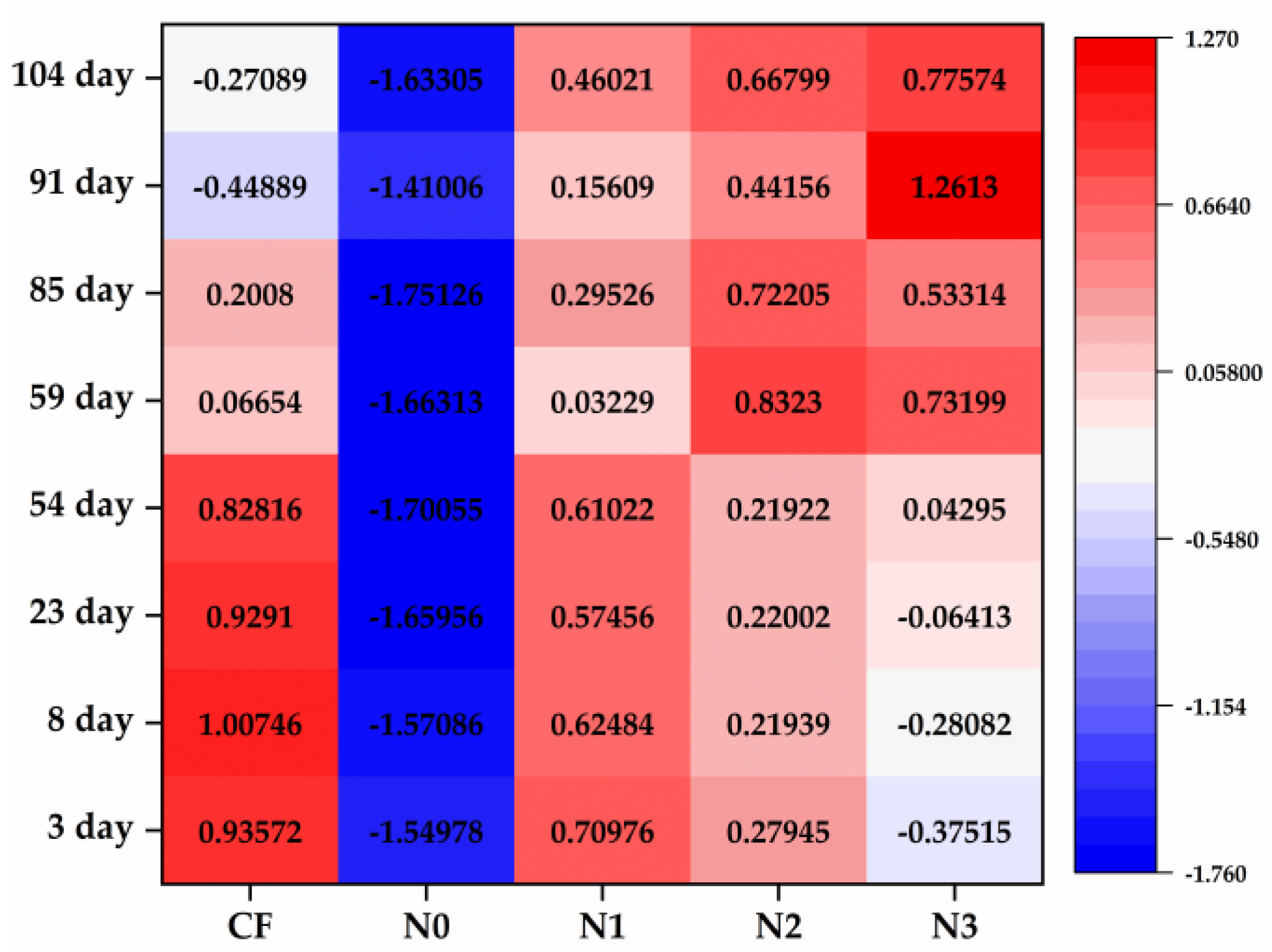

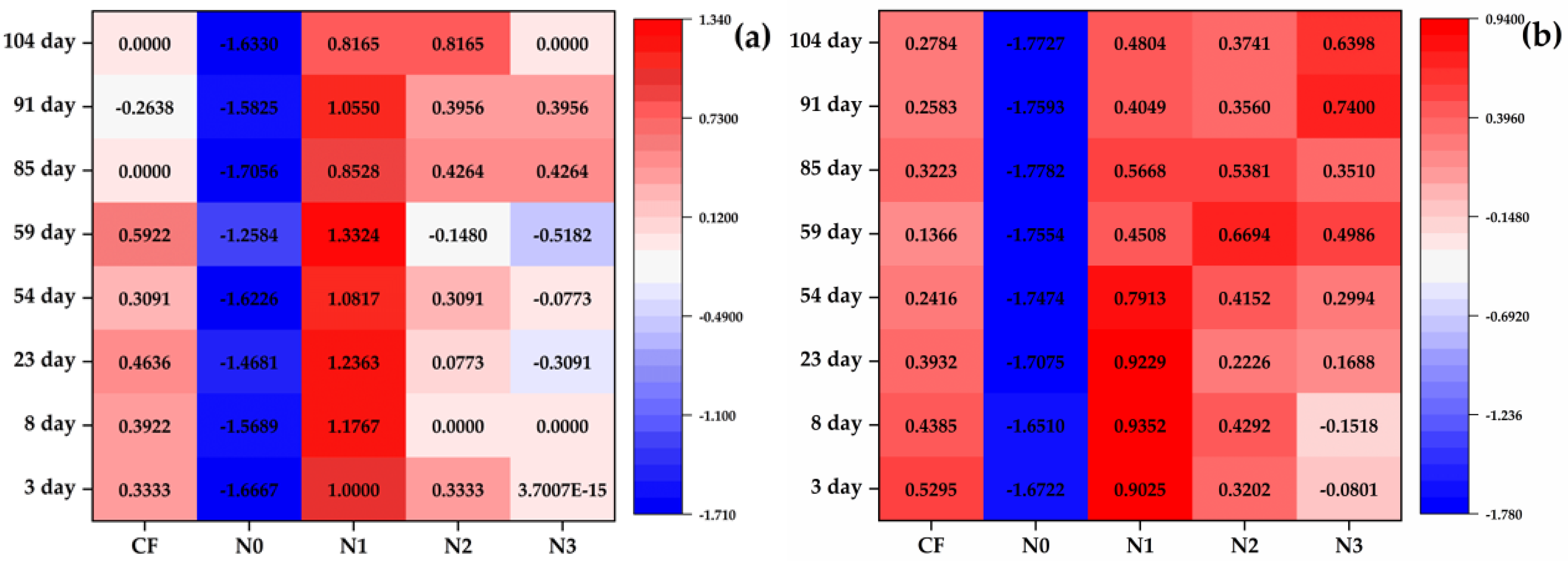



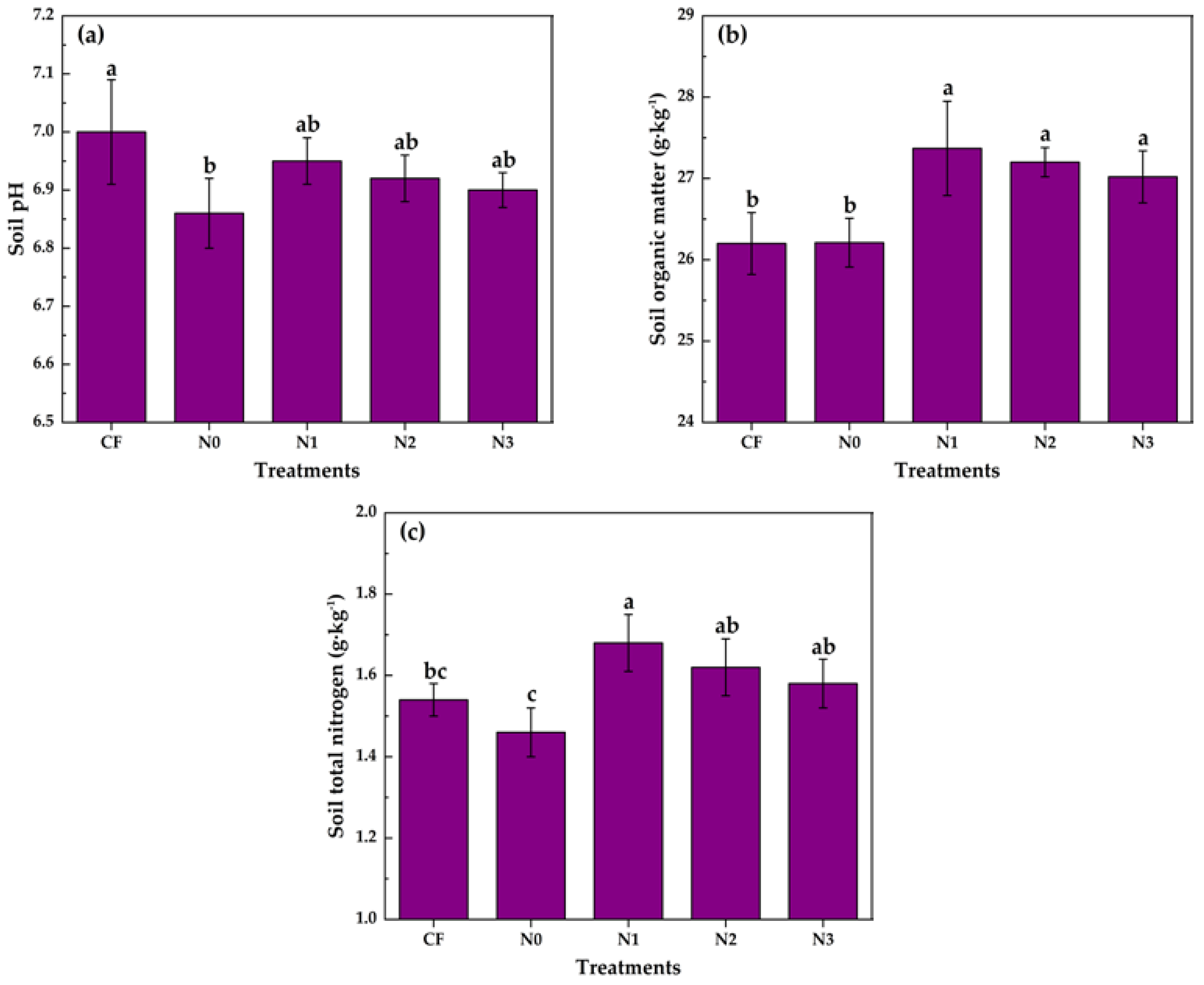

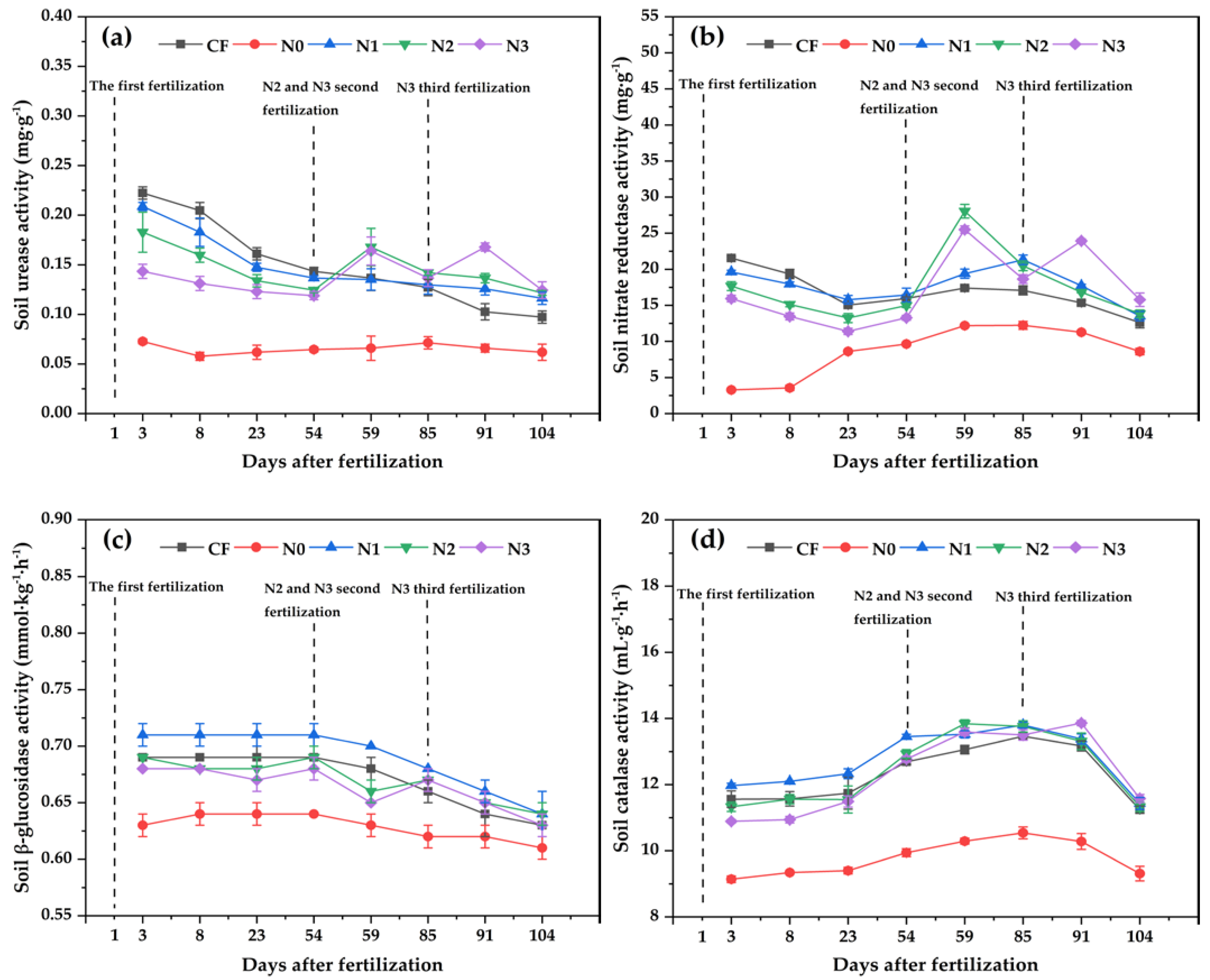
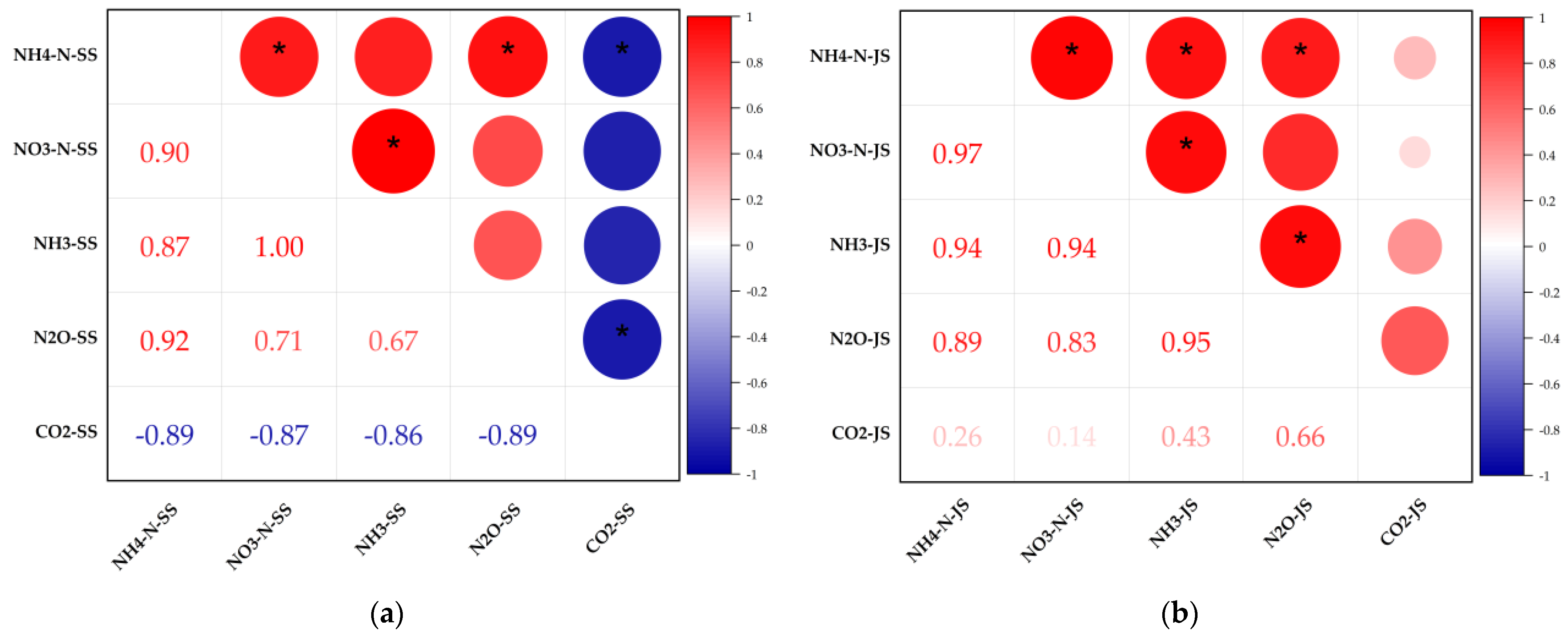
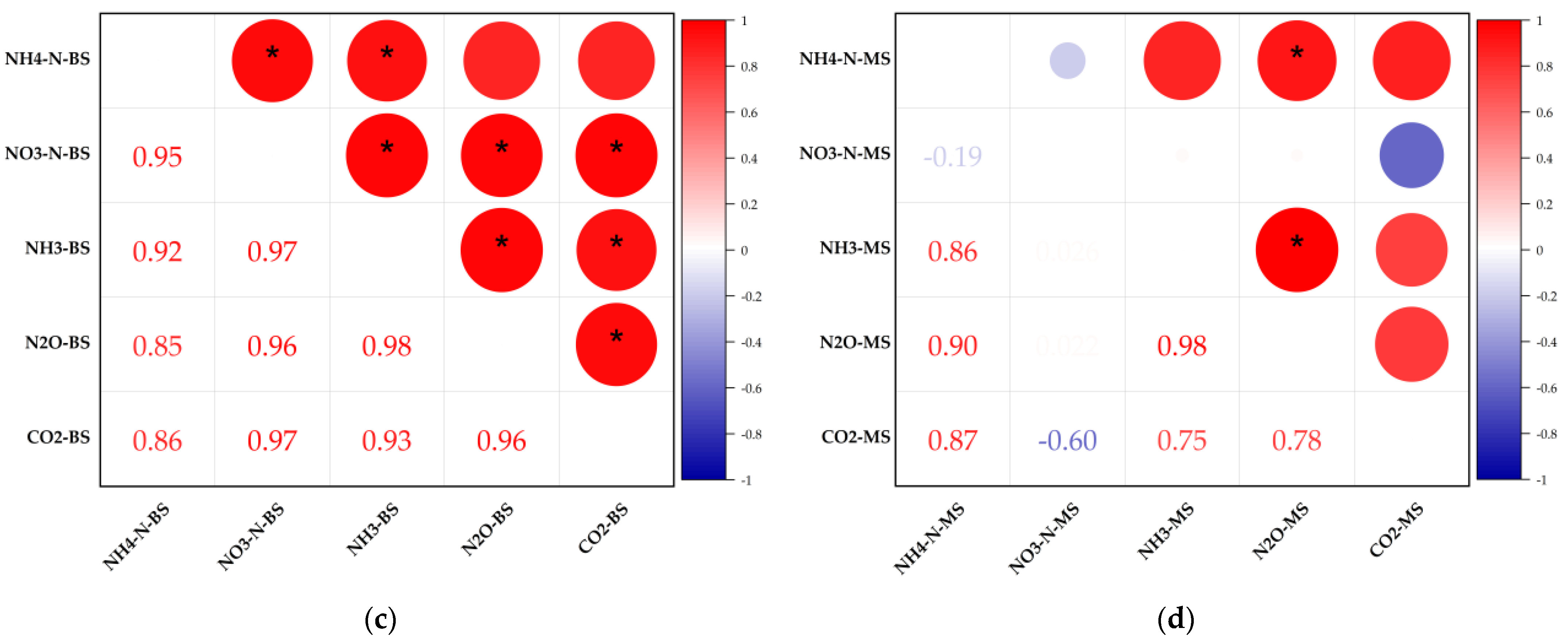
| Treatment | Before Sowing | Jointing Stage | Booting Stage | |||
|---|---|---|---|---|---|---|
| Organic Fertilizer | Urea | Triple Superphosphate | Potassium Chloride | Urea | Urea | |
| CF | - | 163 | 163 | 63 | - | - |
| N0 | - | - | 163 | 63 | - | - |
| N1 | 805 | 123 | 131 | 31 | - | - |
| N2 | 805 | 82 | 131 | 31 | 41 | - |
| N3 | 805 | 41 | 131 | 31 | 41 | 41 |
| Treatment | NH3 | N2O | CO2 | Total EC | ||||||
|---|---|---|---|---|---|---|---|---|---|---|
| ρ | R | EC | ρ | R | EC | ρ | R | EC | ||
| CF | 5.63 | - | 599.64 | 0.84 | - | 337.93 | 468.56 | - | 699.10 | 1636.67 |
| N0 | - | - | 255.67 | - | - | 168.29 | - | - | 393.60 | 817.56 |
| N1 | 2.92 | 48.16 | 433.98 | 0.64 | 23.94 | 297.31 | 302.57 | 35.43 | 590.87 | 1322.16 |
| N2 | 3.54 | 37.08 | 472.10 | 0.70 | 16.27 | 310.33 | 371.61 | 20.69 | 635.89 | 1418.32 |
| N3 | 3.49 | 38.06 | 468.73 | 0.73 | 13.11 | 315.70 | 338.89 | 27.68 | 614.55 | 1398.98 |
| Treatment | SNR (%) | NH4+/NO3− | ||||||
|---|---|---|---|---|---|---|---|---|
| SS | JS | BS | MS | SS | JS | BS | MS | |
| CF | 53.4 ± 0.7 a | 48.3 ± 3.4 a | 41.0 ± 2.1 ab | 45.2 ± 8.5 a | 0.87 ± 0.02 b | 1.08 ± 0.15 a | 1.44 ± 0.12 ab | 1.21 ± 0.04 d |
| N0 | 47.7 ± 1.4 b | 47.1 ± 4.7 a | 45.8 ± 2.1 a | 44.2 ± 1.9 a | 1.10 ± 0.06 c | 1.14 ± 0.20 a | 1.19 ± 0.10 b | 1.27 ± 0.10 d |
| N1 | 46.0 ± 1.0 b | 46.0 ± 3.0 a | 42.3 ± 4.0 ab | 39.7 ± 0.2 b | 1.17 ± 0.05 c | 1.18 ± 0.14 a | 1.38 ± 0.21 ab | 1.52 ± 0.01 c |
| N2 | 45.9 ± 0.1 b | 46.9 ± 3.3 a | 39.9 ± 3.5 b | 37.0 ± 0.9 c | 1.18 ± 0.00 c | 1.14 ± 0.15 a | 1.52 ± 0.21 b | 1.71 ± 0.07 b |
| N3 | 47.8 ± 1.9 b | 45.7 ± 2.1 a | 42.5 ± 0.8 ab | 34.5 ± 2.1 c | 1.09 ± 0.08 c | 1.19 ± 0.10 a | 1.35 ± 0.05 ab | 1.91 ± 0.18 a |
Publisher’s Note: MDPI stays neutral with regard to jurisdictional claims in published maps and institutional affiliations. |
© 2022 by the authors. Licensee MDPI, Basel, Switzerland. This article is an open access article distributed under the terms and conditions of the Creative Commons Attribution (CC BY) license (https://creativecommons.org/licenses/by/4.0/).
Share and Cite
Liu, C.; Zhou, M.; Zhu, Y.; Ma, X.; Wang, Q.; Xu, L.; Zhao, Y.; Zou, W. Gas Emissions and Environmental Benefits of Wheat Cultivated under Different Fertilization Managements in Mollisols. Atmosphere 2022, 13, 1702. https://doi.org/10.3390/atmos13101702
Liu C, Zhou M, Zhu Y, Ma X, Wang Q, Xu L, Zhao Y, Zou W. Gas Emissions and Environmental Benefits of Wheat Cultivated under Different Fertilization Managements in Mollisols. Atmosphere. 2022; 13(10):1702. https://doi.org/10.3390/atmos13101702
Chicago/Turabian StyleLiu, Chunzhu, Meng Zhou, Yingxue Zhu, Xianfa Ma, Qi Wang, Lianzhou Xu, Ying Zhao, and Wenxiu Zou. 2022. "Gas Emissions and Environmental Benefits of Wheat Cultivated under Different Fertilization Managements in Mollisols" Atmosphere 13, no. 10: 1702. https://doi.org/10.3390/atmos13101702





